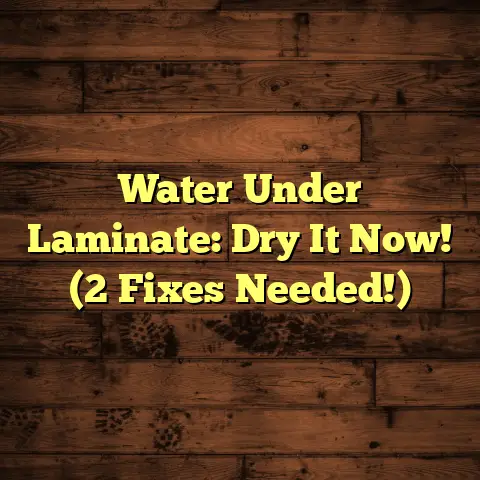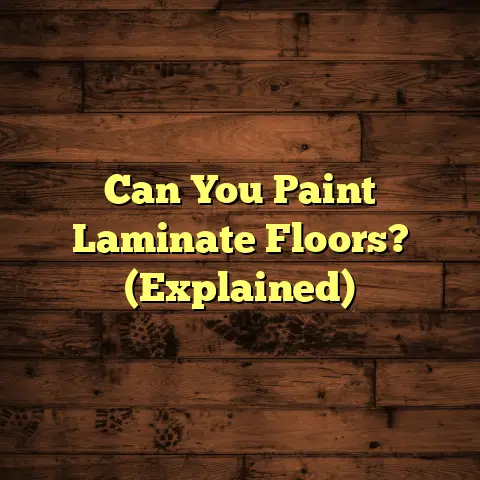Flooring As Backsplash? (3 Install Fails!)
And today, we’re diving headfirst into a trend that’s both exciting and, well, sometimes disastrous: using flooring materials as backsplashes.
Think about it: that gorgeous wood grain, the cool touch of tile, the subtle patterns of vinyl – all gracing your kitchen or bathroom walls.
It’s an innovative approach, no doubt, but trust me, it’s not always a walk in the park.
Texture is everything in interior design.
It adds depth, character, and a tactile dimension that paint alone simply can’t achieve.
Imagine running your hand across the rough-hewn surface of reclaimed wood, or the smooth, cool glaze of a ceramic tile.
Flooring materials offer a wealth of textures – from the pronounced grain of hardwood to the subtle variations in stone-look vinyl.
These textures create a visual statement that contrasts beautifully with traditional backsplash materials like glass or stainless steel.
But here’s the thing: flooring is designed for floors.
Putting it on a wall, especially in a splash zone, requires a whole different level of consideration.
We’re talking moisture, maintenance, and installation challenges that can make or break the whole project.
So, buckle up, because we’re about to explore three real-life install fails that will make you think twice before slapping that leftover flooring on your kitchen wall.
And hey, maybe you’ll even learn a thing or two along the way!
Section 1: The Allure of Flooring Textures in Backsplashes
Let’s get into the nitty-gritty of flooring textures and why they’re so tempting for backsplash applications.
1. Wood Flooring
Ah, wood. The epitome of natural beauty and warmth.
There’s something undeniably cozy about bringing wood into a kitchen or bathroom.
The grain patterns, the knots, the variations in color – it all adds character and a sense of organic charm.
But let’s be real: wood and water are not exactly best friends.
The biggest challenge with using wood as a backsplash is moisture.
Splash zones are, by definition, prone to getting wet.
And wood, when exposed to moisture, can warp, rot, and even become a breeding ground for mold.
Not exactly the vibe you’re going for in your kitchen, right?
That’s why proper sealing is absolutely crucial.
We’re talking multiple coats of a high-quality sealant specifically designed for wet environments.
Even then, regular maintenance is a must.
Wiping up spills immediately and reapplying sealant periodically will help prolong the life of your wood backsplash.
Now, when it comes to wood species, some are better suited for backsplash applications than others.
Teak, for example, is naturally water-resistant due to its high oil content.
Cedar is another good option, as it contains natural oils that help repel moisture and insects.
Oak and maple can also work, but they require extra attention to sealing.
As for finishes, a matte or satin finish is generally preferable to a high-gloss finish, as it will show water spots and scratches less easily.
2. Tile Flooring
Tile is a classic choice for flooring, and it can also make a stunning backsplash.
The sheer variety of tile textures is mind-boggling.
You’ve got matte tiles, which offer a subtle, understated look.
Glossy tiles, which reflect light and add a touch of glamour.
And patterned tiles, which can create a bold, eye-catching statement.
Large-format tiles, which are all the rage right now, can create a seamless, modern look.
The fewer grout lines, the cleaner the overall appearance.
On the other hand, smaller mosaics can add a touch of intricate detail and visual interest.
Don’t underestimate the power of grout!
The color of your grout can dramatically affect the overall texture and appearance of your tile backsplash.
A contrasting grout color will make the tiles pop, while a matching grout color will create a more subtle, integrated look.
Epoxy grout is a great choice for backsplashes because it’s stain-resistant and waterproof.
3. Vinyl and Laminate
Vinyl and laminate flooring have come a long way in recent years.
Thanks to advancements in printing technology, they can now mimic the look and feel of natural materials like wood, stone, and even metal with remarkable accuracy.
This versatility makes them an attractive option for backsplashes, especially for budget-conscious homeowners.
One of the biggest advantages of vinyl and laminate is their ease of installation.
Many products feature click-lock systems that make them relatively easy to install yourself.
They’re also easy to clean and maintain, which is a major plus in a splash zone.
Most vinyl and laminate flooring is water-resistant, making it suitable for high-moisture areas like kitchens and bathrooms.
However, it’s important to note that water-resistant is not the same as waterproof.
Prolonged exposure to moisture can still damage vinyl and laminate, so it’s important to wipe up spills promptly.
Now, before we get too carried away with the possibilities, let’s take a look at some real-life examples of what not to do.
Trust me, these install fails are eye-opening!
Section 2: Install Fail #1 – Wood Flooring Woes
Alright, let’s dive into our first install fail, a cautionary tale of wood flooring gone wrong.
I remember this project vividly.
A client of mine, let’s call her Sarah, was obsessed with the idea of creating a rustic, farmhouse-style kitchen.
Her vision involved using reclaimed wood flooring as a backsplash behind her stove.
She loved the idea of bringing that natural, textured element into the heart of her home.
I tried to gently steer her towards other options, explaining the challenges of using wood in a splash zone.
But Sarah was determined.
She had her heart set on that reclaimed wood, and she wasn’t going to budge.
So, I reluctantly agreed to take on the project, with the understanding that we would take every precaution to protect the wood from moisture.
We started by sourcing some beautiful reclaimed wood flooring with a rich, weathered patina.
The wood was carefully cleaned and sanded to remove any loose debris.
Then, we applied several coats of a high-quality marine-grade sealant, hoping to create a waterproof barrier.
The installation itself was relatively straightforward.
We used construction adhesive to attach the wood planks to the wall, making sure to leave small gaps for expansion and contraction.
But here’s where things started to go wrong.
Despite our best efforts, the sealant wasn’t enough to completely protect the wood from moisture.
Over time, water from cooking splatters and steam seeped into the wood through tiny cracks and imperfections.
Within a few months, Sarah started noticing signs of trouble.
The wood began to warp and discolor, especially in the areas closest to the stove.
Dark stains appeared, and the wood started to feel soft and spongy to the touch.
And then came the worst part: mold.
Tiny black spots started to appear on the surface of the wood, a telltale sign of mold growth.
Sarah was devastated.
Her dream kitchen was turning into a moldy nightmare.
We ended up having to remove the entire wood backsplash and replace it with something more suitable for a splash zone.
The whole experience was a costly and heartbreaking lesson in the importance of understanding material properties.
Here’s what I learned from this disaster:
- Sealing is not a foolproof solution. Even the best sealants can fail over time, especially in high-moisture environments.
- Reclaimed wood is particularly vulnerable. Its porous nature makes it more susceptible to moisture damage.
- Proper ventilation is crucial. Good ventilation can help reduce moisture buildup in the kitchen.
Section 3: Install Fail #2 – Tile Trouble
Now, let’s move on to our second install fail, which involves tile flooring used as a backsplash.
This one is a bit different from the wood flooring disaster, but it’s equally cautionary.
A client of mine, let’s call him Mark, was looking to create a modern, geometric-inspired kitchen.
He fell in love with a particular pattern of porcelain tile flooring that featured bold, angular shapes.
He envisioned using these tiles as a backsplash to create a striking visual statement.
Now, porcelain tile is generally a great choice for backsplashes because it’s durable, water-resistant, and easy to clean.
But in this case, the installation proved to be a major challenge.
The tiles were large and heavy, and their angular shapes made them difficult to align properly.
I hired a subcontractor for this job, and unfortunately, he cut corners on the installation.
He used the wrong type of adhesive, which didn’t provide enough support for the heavy tiles.
He also failed to leave adequate expansion joints between the tiles.
As a result, the tiles started to crack and shift within a few months.
The grout lines became uneven, and the overall appearance of the backsplash was a mess.
But the worst part was the difficulty in cleaning the backsplash.
The uneven grout lines trapped dirt and grease, making it nearly impossible to keep the backsplash clean.
Mark was understandably frustrated.
He had spent a lot of money on the tiles and the installation, and he was left with a backsplash that was both aesthetically unappealing and functionally flawed.
I ended up having to fire the subcontractor and hire a more experienced tile installer to redo the entire backsplash.
The result was a much more successful installation, but it came at a significant cost in terms of time and money.
Here’s what I learned from this experience:
- Don’t cut corners on installation. Hiring a qualified and experienced installer is crucial, especially for complex tile patterns.
- Use the right materials. Using the correct adhesive and grout is essential for a long-lasting installation.
- Pay attention to detail. Proper alignment and spacing are critical for achieving a professional-looking result.
As a fellow contractor, [Another Contractor Name] said, “The devil is in the details when it comes to tile installation. One small mistake can lead to big problems down the road.”
Section 4: Install Fail #3 – Vinyl and Laminate Disasters
Okay, let’s move on to our final install fail, which involves using vinyl or laminate flooring as a backsplash.
This is a common mistake, especially among DIYers who are looking to save money.
Vinyl and laminate flooring can be relatively inexpensive and easy to install, making them an attractive option for budget-conscious homeowners.
But trust me, using them as a backsplash is often a recipe for disaster.
I once had a client, let’s call her Lisa, who decided to install laminate flooring as a backsplash in her laundry room.
She liked the look of the wood-grain laminate and thought it would add a touch of warmth to the otherwise sterile space.
She installed the laminate herself, using construction adhesive to attach the planks to the wall.
At first, everything looked great.
The laminate backsplash looked clean and modern, and Lisa was thrilled with the result.
But within a few months, problems started to emerge.
The edges of the laminate planks began to peel away from the wall, especially in areas that were exposed to moisture.
Visible seams appeared between the planks, and the overall appearance of the backsplash deteriorated rapidly.
The laminate also proved to be difficult to clean.
Spills and splatters tended to seep into the seams, leaving unsightly stains.
Lisa eventually realized that she had made a mistake by using laminate as a backsplash.
She ended up having to remove the laminate and replace it with a more suitable material.
Here’s what I learned from Lisa’s experience:
- Vinyl and laminate are not waterproof. Prolonged exposure to moisture can damage these materials.
- Adhesive alone is not enough. Laminate and vinyl need additional support, especially on vertical surfaces.
- Seams are a weak point. Seams between planks are susceptible to moisture damage and staining.
Now, it’s not all doom and gloom when it comes to using vinyl or laminate as a backsplash.
There are some successful examples out there, but they typically involve using high-quality, waterproof vinyl panels specifically designed for backsplash applications.
These panels are usually thicker and more durable than standard vinyl flooring, and they feature interlocking edges that create a watertight seal.
But even with these specialized products, proper installation is crucial.
Conclusion: Lessons from Flooring as Backsplash Fails
So, there you have it: three real-life install fails that highlight the challenges of using flooring as a backsplash.
I hope these cautionary tales have shed some light on the importance of understanding material properties and installation techniques.
While the idea of repurposing flooring for backsplashes can be tempting, it’s essential to weigh the risks and benefits carefully.
Flooring materials offer a wealth of textures and design possibilities, but they’re not always the best choice for splash zones.
Moisture, maintenance, and installation challenges can all contribute to disastrous results.
If you’re considering using flooring as a backsplash, I urge you to do your research, consult with a professional, and choose your materials wisely.
And remember, proper installation is key to achieving a long-lasting and aesthetically pleasing result.
Don’t cut corners on installation, use the right materials, and pay attention to detail.
By understanding the potential pitfalls and taking the necessary precautions, you can create a stunning backsplash that will enhance the beauty and functionality of your home for years to come.
And hey, even if you decide that flooring isn’t the right choice for your backsplash, there are plenty of other creative options out there.
From glass tiles to natural stone to stainless steel, the possibilities are endless.
So, go forth and create a backsplash that reflects your personal style and enhances the overall design of your home!





